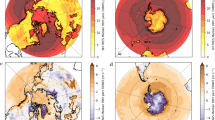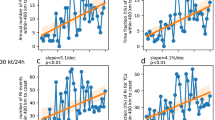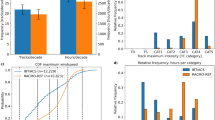Abstract
In 2014 and 2015, post-monsoon extremely severe cyclonic storms (ESCS)—defined by the WMO as tropical storms with lifetime maximum winds greater than 46 m s−1—were first observed over the Arabian Sea (ARB), causing widespread damage. However, it is unknown to what extent this abrupt increase in post-monsoon ESCSs can be linked to anthropogenic warming, natural variability, or stochastic behaviour. Here, using a suite of high-resolution global coupled model experiments that accurately simulate the climatological distribution of ESCSs, we show that anthropogenic forcing has likely increased the probability of late-season ECSCs occurring in the ARB since the preindustrial era. However, the specific timing of observed late-season ESCSs in 2014 and 2015 was likely due to stochastic processes. It is further shown that natural variability played a minimal role in the observed increase of ESCSs. Thus, continued anthropogenic forcing will further amplify the risk of cyclones in the ARB, with corresponding socio-economic implications.
This is a preview of subscription content, access via your institution
Access options
Access Nature and 54 other Nature Portfolio journals
Get Nature+, our best-value online-access subscription
$29.99 / 30 days
cancel any time
Subscribe to this journal
Receive 12 print issues and online access
$209.00 per year
only $17.42 per issue
Buy this article
- Purchase on Springer Link
- Instant access to full article PDF
Prices may be subject to local taxes which are calculated during checkout




Similar content being viewed by others
References
Tropical Cyclone Operational Plan for the Bay of Bengal and Arabian Sea WMO/TD-84 (WMO, 2015); www.wmo.int/pages/prog/www/tcp/documents/TCP-21Edition2015_final.pdf
Kruk, M. C. Tropical cyclones, North Indian Ocean. Bull. Amer. Meteorol. Soc. 97(8) (Suppl.), 114–115 (2016).
Evan, A. T., Kossin, J. P., Chung, C. E. & Ramanathan, V. Arabian Sea tropical cyclones intensified by emissions of black carbon and other aerosols. Nature 479, 94–97 (2011).
Wang, B., Xu, S. & Wu, L. Intensified Arabian Sea tropical storms. Nature 489, E1–E2 (2012).
Evan, A. T. & Camargo, S. J. A climatology of Arabian Sea cyclonic storms. J. Clim. 24, 140–158 (2011).
Kossin, J. P., Olander, T. L. & Knapp, K. R. Trend analysis with a new global record of tropical cyclone intensity. J. Clim. 26, 9960–9976 (2013).
Knutson, T. et al. Tropical cyclones and climate change. Nat. Geosci. 3, 157–163 (2010).
Murakami, H. et al. Simulation and prediction of Category 4 and 5 hurricanes in the high-resolution GFDL HiFLOR coupled climate model. J. Clim. 28, 9058–9079 (2015).
LaRow, T. E., Lim, Y.-K., Shin, D. W., Chassignet, E. P. & Cocke, S. Atlantic basin seasonal hurricane simulations. J. Clim. 21, 3191–3206 (2008).
Zhao, M., Held, I. M., Lin, S.-J. & Vecchi, G. A. Simulations of global hurricane climatology, interannual variability, and response to global warming using a 50km resolution GCM. J. Clim. 22, 333–363 (2009).
Manganello, J. V. et al. Tropical cyclone climatology in a 10-km global atmospheric GCM: toward weather-resolving climate modeling. J. Clim. 24, 3867–3893 (2012).
Murakami, H., Sugi, M. & Kitoh, A. Future changes in tropical cyclone activity in the North Indian Ocean projected by high-resolution MRI-AGCMs. Clim. Dyn. 40, 1949–1968 (2013).
Murakami, H. et al. Future changes in tropical cyclone activity projected by the new high-resolution MRI-AGCM. J. Clim. 25, 3237–3260 (2012).
IPCC Climate Change 2007: The Physical Science Basis (eds Solomon, S. et al.) (Cambridge Univ. Press, Cambridge, 2007).
Murakami, H. et al. Seasonal forecasts of major hurricanes and landfalling tropical cyclones using a high-resolution GFDL coupled climate model. J. Clim. 29, 7977–7989 (2016).
Murakami, H. et al. Investigating the influence of anthropogenic forcing and natural variability on the 2014 Hawaiian hurricane season. Bull. Amer. Meteorol. Soc. 97(12) (Suppl.), 115–119 (2016).
Murakami, H. et al. Dominant role of subtropical Pacific warming in extreme eastern Pacific hurricane seasons: 2015 and the future. J. Clim. 30, 243–264 (2017).
Vecchi, G. A. & Soden, B. J. Effect of remote sea surface temperature change on tropical cyclone potential intensity. Nature 450, 1066–1071 (2007).
Vecchi, G. A. & Soden, B. J. Increased tropical Atlantic wind shear in model projections of global warming. Geophys. Res. Lett. 34, L08702 (2007).
Sugi, M., Murakami, H. & Yoshimura, J. A reduction in global tropical cyclone frequency due to global warming. SOLA 5, 164–167 (2009).
Murakami, H., Mizuta, R. & Shindo, E. Future changes in tropical cyclone activity projected by multi-physics and multi-SST ensemble experiments using the 60-km-mesh MRI-AGCM. Clim. Dyn. 39, 2569–2584 (2012).
Taylor, K. E., Stouffer, R. J. & Meehl, G. A. An overview of CMIP5 and the experiment design. Bull. Amer. Meteorol. Soc. 93, 485–498 (2012).
IPCC Climate Change 2013. The Physical Science Basis (eds Stocker, T. F. et al.) (Cambridge Univ. Press, Cambridge, 2013).
Murakami, H., Wang, B., Li, T. & Kitoh, A. Projected increase in tropical cyclones near Hawaii. Nat. Clim. Change 3, 749–754 (2013).
Chu, J.-H., C. R. Sampson, Levin, A. S. & Fukada, E. The Joint Typhoon Warning Center Tropical Cyclone Best Tracks 1945–2000 NRL; https://www.gfdl.noaa.gov/cm2-5-and-flor/
Knapp, K. R., Kruk, M. C., Levinson, D. H., Diamond, H. J. & Neuman, C. J. The international best track archive for climate stewardship (IBTrACS): unifying tropical cyclone best track data. Bull. Amer. Meteorol. Soc. 91, 363–376 (2010).
Unisys Weather Hurricane/Tropical Data (UNISYS, 2017); http://weather.unisys.com/hurricane/
Rayner, N. A. et al. Global analysis of sea surface temperature, sea ice, and night marine air temperature since the late nineteenth century. J. Geophys. Res. 108, 4407 (2003).
Kobayashi, S. et al. The JRA-55 reanalysis: general specifications and basic characteristics. J. Meteorol. Soc. Jpn 93, 5–48 (2015).
Jaeger, C. C., Krause, J., Haas, A., Klein, R. & Hasselmann, K. A method for computing the fraction of attributable risk related to climate damages. Risk Anal. 28, 815–823 (2008).
Chiang, J. C. H. & Vimont, D. J. Analogous Pacific and Atlantic meridional modes of tropical atmosphere–ocean variability. J. Clim. 17, 4143–4158 (2004).
Mantua, N. J., Hare, S. R., Zhang, Y., Wallace, J. M. & Francis, R. C. A Pacific interdecadal climate oscillation with impacts on salmon production. Bull. Amer. Meteorol. Soc. 78, 1069–1079 (1997).
Saji, N. H., Goswami, B. N., Vinayachandran, P. N. & Yamagata, T. A dipole mode in the tropical Indian Ocean. Nature 401, 360–363 (1999).
Wang, B. & Fan, Z. Choice of south Asian summer monsoon indices. Bull. Amer. Meteorol. Soc. 80, 629–638 (1999).
Acknowledgements
The authors thank T. L. Delworth and L. Krishnamurthy for their suggestions and comments. H.M. appreciates P.-C. Hsu for her editorial service support. This report was prepared by H.M. under award NA14OAR4830101 from the National Oceanic and Atmospheric Administration (NOAA), US Department of Commerce. The statements, findings, conclusions and recommendations are those of the authors and do not necessarily reflect the views of the NOAA or the US Department of Commerce.
Author information
Authors and Affiliations
Contributions
H.M. designed the study, carried out the experiments and analysed the results. G.A.V. and S.W. carried out the experiments and made comments on the manuscript.
Corresponding author
Ethics declarations
Competing interests
The authors declare no competing financial interests.
Additional information
Publisher’s note: Springer Nature remains neutral with regard to jurisdictional claims in published maps and institutional affiliations.
Electronic supplementary material
Rights and permissions
About this article
Cite this article
Murakami, H., Vecchi, G.A. & Underwood, S. Increasing frequency of extremely severe cyclonic storms over the Arabian Sea. Nature Clim Change 7, 885–889 (2017). https://doi.org/10.1038/s41558-017-0008-6
Received:
Accepted:
Published:
Issue Date:
DOI: https://doi.org/10.1038/s41558-017-0008-6
This article is cited by
-
Effect of “spiciness” on the intensification of cyclones over Arabian Sea - a case study on Biparjoy
Climate Dynamics (2024)
-
Dynamics of land, ocean, and atmospheric parameters associated with Tauktae cyclone
Environmental Science and Pollution Research (2024)
-
Changes in the thermodynamical profiles of the subsurface ocean and atmosphere induce cyclones to congregate over the Eastern Arabian Sea
Scientific Reports (2023)
-
Intensification of Arabian Sea cyclone genesis potential and its association with Warm Arctic Cold Eurasia pattern
npj Climate and Atmospheric Science (2023)
-
Pacific decadal oscillation causes fewer near-equatorial cyclones in the North Indian Ocean
Nature Communications (2023)



